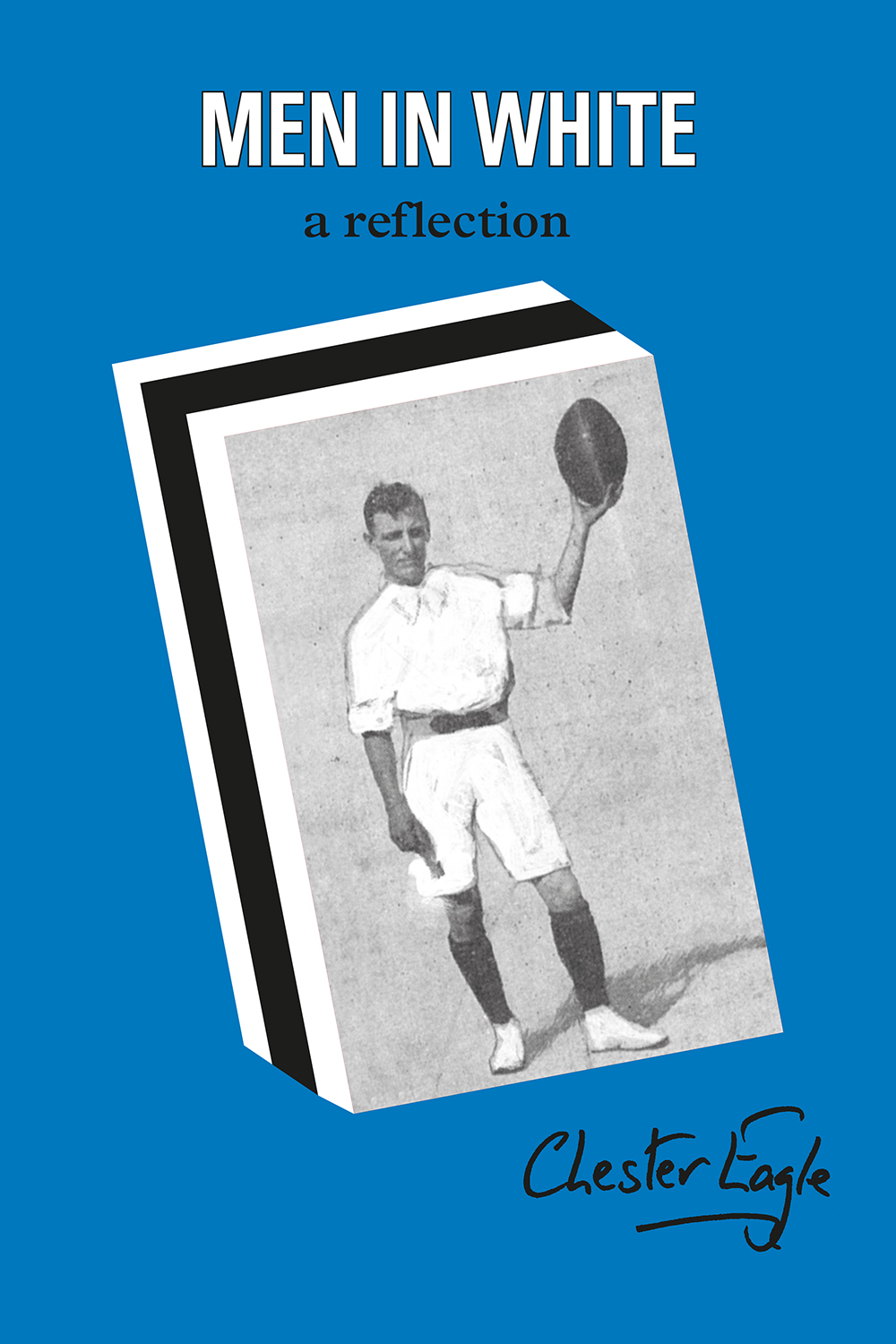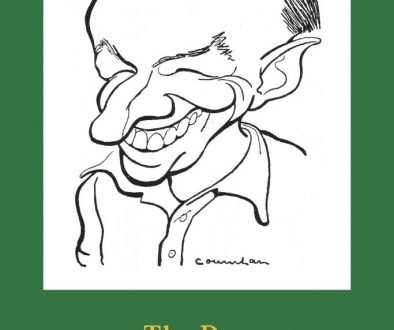Men In White

Written by Chester Eagle
Designed by Vane Lindesay
Layout by Karen Wilson
Circa 4,350 words
Electronic publication by Trojan Press (2012)
Men In White:
I was looking at a picture of Don Bradman the other day, and the familiar things were there – an adoring crowd pressing close, a policeman or two, the Don in white, bat in hand, aware of his reception but trying to keep his concentration in order … did I say ‘in white’? Yes I did, he was wearing the green and gold Australian cap, and beyond that, the no-colour which represented a state of virtue. That white, which represents something still associated with Test cricket, the five-day game as it’s called today, carries meanings which are being replaced in later forms of the game. There is, as you know, such a thing as T20 cricket, and one day cricket, and the players of these forms wear colourful uniforms to indicate the identity of their nation … if they represent a nation, and that, I think brings us to a question about the meanings of the game, past, present and future …
Games do carry meanings, but usually they are so embodied in their social surroundings that we take them for granted. They are, we assume, what they’ve always been. This is largely a matter of where we look. We can drive around our cities or country towns on a Saturday afternoon, slowing to have a look at the cricketers we’ll see all over the place, and, reassured by their locales – humble, if pleasantly green – we’ll take it for granted that the traditional game is alive. This is a tempting thought for me because my father was captain of our local team and going to cricket on Saturdays to watch Finley at home, at Tocumwal, or Jerilderie was as normal as the rising and setting sun. Men played cricket. It was what they did in the time they knew as ‘spare’. Cricket was so natural in the world of my growing up that nobody examined it as a creation that might have been otherwise. Why on earth would you change cricket? England had done it with bodyline, and how disgraceful that had been. Yet even to mention bodyline is to admit that cricket can be subject to things not entirely created within its boundaries, those long curves of wire, or chain, or fencing, enclosing fields of play. From the humblest rural paddocks to the dignity of Sydney or Melbourne, cricket was an empire responding to the empire which had brought it into being, spreading it through the English-speaking world. Australia was somewhere between a rich country and a poor one, but its cricketing arenas were grand. Cricket was a way for a society to express itself, choose its challenges and take them on, successfully if possible, one by one.
Hence those pictures of the Don. I knew about him before I knew much else. He’d been so good that he’d frightened England, and only Germany had been able to do that. The English ganged up on him with a new form of attack, he survived, cricket survived, and he outlasted the war that might have ended him. He came back. The English discovered that they loved him because he represented what they’d been before the second of the wars that finished their empire. England should never have gone in to bat against Germany. They should have boasted in their pubs about how they could beat them, without ever taking them on! Some things are too important to be put to a test!
But then, a test is a test is a Test, no? Test matches are the most serious matches, bringing nations against each other as con-test-ants. Tests take place between nation states, and they are, or rather they were, the biggest players you could have. This is changing, and it’s these changes that make my subject, here, today. The game is not what it was, but no game ever is, because games represent a society so that it can understand itself, and then assert its understanding in a way that makes it feel good.
Cricket is a man’s game. It’s only recently that women have been able to play it well, and it may be – it’s an open question, in my mind – that its combination of individualism and teamwork is more suitable for men than for women, having been developed in a rather limited sort of way. Cricket is more resistant to having its rules changed than most games, so its evolution will be slowed, or so it seems to me. A man’s game. Silly as it may sound, this brings us back to its players wearing white.
You may think this obvious for a game that goes on for hours in what Australians know as, and the English call, the heat of summer. White garments reflect, making them appropriate for a summer game. But white has connections with sanctity, being passionless, and the virtuous presentation of one’s self. White is the colour associated with purity, and this leads us to the question of how such a state can be associated with a contest where two sides are determined to beat each other. It can’t be done!
The answer lies in the regulation of the game. The rules. Every captain is supposed to know them and the umpires – remember the umpires! – are there to see they’re followed. I almost said ‘obeyed’, but when the game’s being played properly – in the right spirit! – we can take it for granted that the rules are obeyed. Cricket wouldn’t be cricket without respect for the rules, the traditions, the fellow-feeling of teams who, however fiercely they contest, are happy to socialise at the end of a day’s play. Someone from the victorious team will knock on the dressing room door of the beaten and ask them in for a drink. That’s how it’s supposed to be. Even the umpires may join in at the end of a game, though not while it’s underway. They must be seen to remain impartial; look at them, in their black and white. Their white means impartiality, with the black imposing a certain menace, because they can rule a batsman out, and they do it, all the time. When the umpire lifts his finger, the batsman has to go … or that’s how it used to be. The game, as I say, is changing. In modern international games there’s a third umpire sitting upstairs, and perhaps a match referee. This keeps former international players in the circuit, as it were, employed and paid. The modern game is defined not only by its traditions but by the moneyed world it’s part of, and that’s an influence that’s going to increase. The Australian cricket captain’s now paid more than the Australian Prime Minister, though neither of them rates as highly as the CEO (you know what that means) of a bank! In the Christian world from which Europe’s still emerging, virtue was its own reward, but this isn’t so any more. Nations choose their teams from squads who are placed on contracts, and these have to be negotiated with agents, who have stables of likely colts for the international race!
I was talking about rules; we have to have rules. The rules are linked to the sense of virtue that the game enacts. Political rules, the rules of the society gazing benevolently on the game, are not the same as the rules of the field, but the two are glancing at each other all the time. Good behaviour, even admirable behaviour, in the course of play will be mirrored in the praise of commentators. And vice versa: ‘It isn’t cricket!’ is a condemnation that can be used for condemning anything, but what it reveals, to me, is that cricket is a standard for the behaviour expected anywhere, any time, except when something darker needs to be done. This is a peculiarly British way of doing things and it’s never been adopted by the Americans, Russians, French, or anybody except those countries whose moeurs have been shaped by their participation in the Empire …
That word again. The British did shape the world for a long time, and now their power’s dying, we find ourselves coming under other influences. What are they? This isn’t easy to define, so let’s look at what’s happening in our chosen area, the world of sport, and see what we can see, but please bear with me if I swing across, for a moment, to the world of football, Australian Rules. This game may be unknown to you, but you’ll see what I’m talking about if you watch some old film and some modern video of the game. The umpires have changed. Once, they wore white. Field umpires and boundary umpires wore white, goal umpires wore white and black. The teams, opposing each other, were recognisable by their colours, treasured, even hallowed, over many years. Hawthorn, in brown and gold, played Melbourne, in red and blue. And so on. The contest lay between the colours, the umpires’ impartiality was shown by what they wore. Footballing umpires, like cricketing umpires, identified themselves as white; they were impartial, and you knew this because they abjured colour.
They do this no longer. The key to their dress, these days, is that they are on television so they, like the teams they judge, need to offer the viewers colour – or so the stations say. TV stations are governed by ratings, which means the number of viewers they can attract, linking, of course, to the rates they charge for advertisers to have access to those viewers who, don’t forget, may change channels at any given time. Holding the public in position so that some advertising, some impress on their brains, can be implanted, is the purpose, underlying no doubt, but certain enough, if you think about it, of a modern game. Or do we need to change that statement? Perhaps the purpose of a game, these days, is not the excitement of the contest, or even the result, but the opportunity it provides for the enslavement of those who watch? If we swing back, now, to a test match between two cricketing nations, we have to see the crowds, not as people spontaneously and naturally excited by the doings of the players with whom they identify, but as dupes, people who think they are watching for one set of reasons but who are being held in position by one set of forces so that another can be applied to their brains.
Common sense would suggest that doing this to the public is easier if those who are watching don’t think too closely about what’s happening. That’s to say, it’s better for all involved if people don’t understand the changes I’ve been talking about. This links, I think, with the question of who, actually, is the crowd at any given game. Is it the people who’ve come through the turnstiles, or is it the possibly much larger crowd watching via the camera, within range of their colour TV? They are two different crowds, aren’t they? So what is going on? Who is doing what to whom?
This isn’t as easy to answer as it once was. Cricket in the Bradman era – and how long did that last? Did it die with the Don, or was it simply dying? – possessed a simple rule of authority. Captains captained their teams; umpires’ word was law. My father, already mentioned, liked to tell of a batsman who complained that he’d been given out wrongly; the umpire, secure behind the stumps at the bowler’s end, said, ‘You have a look in the paper on Monday morning and you’ll see if you were out or not!’
He was out because the umpire said so. Television has replaced this certainty with something more ambivalent. Players on the ground appeal, the umpire gives a ruling and the people upstairs study replays. The question, of course, is what happened? Did the ball touch the bat, the glove, some other part of the batsman’s clothing, or was the sound produced by something else? The camera people are quick. Within moments they have a replay, which they show over and over. Umpires make mistakes. Certainties, which were always articles of faith, aren’t certainties any more. Yes, if the umpire raises his finger the batsman has to go but that’s because the power to dismiss him hasn’t yet followed the new reality of where the knowledge lies. It’s in the cameras, now, and the commentary box, because the umpire is now a player – that is, he’s acting within the limits of his abilities, and they’re rather circumscribed by comparison with the position of the commentators who intervene in the process of bringing us the game. Isn’t that indicative, expressive, of the new power of the media in the modern world? Let’s not forget why we’re watching. We are being diverted from thoughts that might occur to us if we considered the political nature of the world we’re in. It’s not good for us to know. We shouldn’t think too hard, nor let loose our powers of analysis, such as they may be. The game, any game, is in the curious position of representing a reality when the so-called reality is that it is, in itself, a diversion from some other reality, veiled, unspoken, hidden as far as possible.
The commentators chuckle. They are paid to opine. They do it surprisingly well; most are former players, perhaps captains of the very teams competing on the screen. Notice that I said ‘on the screen’, which is not the same thing as ‘on the ground’, though sometimes, often enough, the distinction needs to be blurred. The game is happening somewhere, it’s simply that it doesn’t much matter where. Have you noticed, as I have, that our screens show us golfers putting, driving, or picking their ball out of the hole without telling you where the tournament is being played? Or racing drivers hurtling in their death-and-destruction way around a track in a city that hasn’t been identified? What’s important is that these things be done, and be watched by viewers worldwide, regardless of the particular circumstances – the locale – which attaches a pretence of reality to these necessary fictions. The story is more powerful than the people, the realities, that give it life. What matters is that people should believe the story – as it’s delivered – rather than that it actually happened. Who cares whether it happened, or where? What matters is the faith created that the system in which we all operate is still functioning. It’s a system built on faith and it needs a little dash of faith, everywhere and all the time, to keep it going.
You may feel that I’m taking my argument to an extreme, but let me test it by returning to that idea of the symbolism of white, white as virtue or a sign thereof. We are talking about cricket, remember. Nations get around in colours, these days. Australia’s true to green and gold. New Zealand – aha! – used to be famous for rugby before they bothered much about cricket. Their rugby teams wore black. They were known as the All Blacks. Nobody noticed, nobody cared. But when this modest nation had to put its cricket teams in colours, they went for a colossal contradiction of the past, an all-black cricket team, and so it is today. The idea of virtue presented by a team of cricketers walking onto the field has been contradicted by developments of the modern game. Once, they walked on, those cricketers, today, they sometimes run. Or jog. The symbolisms of their behaviour, their dress, are changing, because the meanings of the game are being altered, because, if the functions of sport are to keep happening, the symbolisms have to change with the realities being symbolised. None of this is simple. We, whether we speak of ourselves as individuals or as whole societies, rarely understand what we are about. We create explanations, fictions quite probably, to explain ourselves. Then we convince ourselves that they can be believed. Faith is what matters most and it doesn’t much matter how it’s created, or what it’s created from. Its very existence, like those cars racing in cities we can’t identify, is what counts.
It may be that my argument is puzzling. You don’t see where this is going? Let me start again, therefore, with that picture of Australia’s hero, Bradman, entering the field at Melbourne, bat in hand, cap on his head to show who he represented – all of us, Aussies through and through – trying to keep his concentration steady while his eyes adjust to the light, because his performance will depend on how quickly he picks up the spin, the movement, of the ball. What we know, you and I, looking at the Don, is that he will be, that day and throughout a long, war-interrupted career, brilliantly successful. We can trust him to succeed. My father, when I was a child and following him around the paddocks, told me about a game at the MCG when Bradman tore the bowlers apart. ‘The outer was packed and they were roaring like a football crowd,’ father said, and he’d been there, as I had not. I knew this meant something larger than my little life. All of us were part of something bigger than we could understand, let alone control. People wanted to pour their passions into something larger than themselves, it’s something people need to do, dangerous as it is, as ever so many wars have shown us.
People wanted …
People always want. People exist in a state of endless yearning, and their – our – problems are too big. We want to be told. Convincing leaders can normally get their way by saying what people want to hear. It’s an old formula and we’ll see it again, probably every day! There’s an endless tension between reality, which we both want and don’t want to understand – it may be uncomfortable! – and the representations of reality we’re prepared to consider. Now that communism’s over as a threat, the capitalist world has turned to sport as its favourite means of giving the public something to think about without making them think too deeply, or too hard. Sport represents contest, played within a set of rules. Umpires are still in control, and we can see they’re good men because their white shirts, these days, tell us to fly with Emirate Airlines. Umpires may fly with any airline they like, and we’re unlikely, you and I, ever to know which one they fly with, because, being good consumers, they have freedom of choice. A well-placed bargain may divert them from one airline to another, in the competitive spirit of modern capitalism, and when this happens the world will be functioning as it’s supposed to do. There are rules, there are customs, conventions, and there’s the spirit of the game, but what you say, what you expound publicly, doesn’t have to be what you do when you’re not exposed. Nobody expects you to be consistent with your public utterances, because they’re being paid for, and it’s what you say that matters, not what you do. Purity and consistency, thorough, deeply-convicted sincerity is not as important any more.
Why is this? It’s because in a Christian world-view, or certainly as such things existed a few centuries back, in the time of the counter-Reformation’s ideological warfare, souls were thought to be imperilled. Souls were endangered by the commission of mortal sin. Hell existed for people who died in such a state. Was ever anything so silly, to the modern mind? Hell still exists as some sort of compass-point, but not as a threat, not as a reality. Hell, these days, is about as frightening as New Zealand cricketers in black. It’s a statement, an indication, of some sort, but it’s so old-fashioned as to be an opportunity to laugh rather than to quake at the knees. Our minds aren’t full of terror any more.
What have we put in its place? My answer, quirky as it may seem, is statistics. Stats. Columns and columns of numbers. Figures rule the world these days, and the effect of this is that nobody expects absolutes any more. If the numbers are rising, that’s good; if millions are turning into billions, and the sky’s still there as the only limit, it doesn’t matter if we possess everything. Nobody ever gets the lot, but if what they hold is still going up, and paying good dividends to shareholders, then things are looking fine. I am inviting you, dear reader, to observe the death of the absolute, the ultimate. It’s not part of our thinking any more. If we’ve got a big share, and we’re doing well, that’s enough. Nations, endlessly nibbled, perhaps devoured, by multinationals, do their best to hold the line but the commercial forces they try to withstand are frequently larger than they are. Minor ‘nations’ are small players these days. Some of them hardly know how to hold their bats! Some of them are happy to sell them; what do you think all those well-dressed Africans are doing in Paris? Ensuring benefits for their poverty-stricken villagers back home?
So let’s look at him, Don Bradman, entering the MCG with the hopes of his country on his shoulders, our immortal Don. He’s not much loved by his fellow players because he’s too good. At the end of a day’s play, when his team mates – mates? Such an unsuitable word – are downing a few beers, or quite a few beers, he’s listening to music in his room because he needs to quieten, to restore, his soul. He plays the game with a completeness, an absolutism, that most cricketers don’t understand. It’s as if it is only he who understands what it’s really about. The reality he persists in attacking doesn’t want to be defined, except in terms favourable, restorative, to the mental health of those being affected by the events of the world. I say he wasn’t entirely popular, though the crowds roaring in the outer wouldn’t have told you this. They loved him for representing them victoriously, when they knew only too well that those he played against were in some sense our enemies despite all the expressions of goodwill on either side. National contests mattered, in those days, because nations enriched themselves, in the days of empire, at the expense of others. It was the way the system worked, and though this is still the case, it’s changing, and we are still working out what those changes are. Hence the abandonment of absolutes, and the swing to statistics, which offer endless measurement but no finality. Finality’s to be feared because it would mean that the game wasn’t being played any more. What game, you say? The financial game, the power-game, or the imitative world of cricket? Of teams, clad in whatever they’re wearing these days, or larger, more subterranean, forces not easily quantified or defined?
There’s always more than one way of playing. Bradman, the finest player the world has ever known, named Stan McCabe, an Irishman from New South Wales, as having played the greatest innings he’d seen. ‘If I could play an innings like that,’ he told McCabe after one Adam Gilchrist-like demonstration, ‘I’d be a proud man!’ McCabe was one of the Irish who didn’t look at the game as Bradman did. He played with daring and dash, as did Keith Miller, another great who wasn’t in sympathy with the Don. They saw cricket as an activity in itself, flung themselves into it, ignoring the dimension I have been at pains to show. I think each of them would have hated to see himself as a player on that larger stage because he used it as his own stage to defy the outside, super-encumbering forces which Bradman, I am saying, knew quite well. Sports men, sports women, are public property, entering the field for even the most trivial contest with some degree of responsibility, via the representative nature of the game they play, for the world they are leaving behind, the world, dear reader, that you and I are shaped by, and have to put up with. What we can regret, I think, is the considerable diminution of the power exercised over the world by political forces which once gave us a means to affect the world we may have been displeased by. If we felt dissatisfied, we could express ourselves in politics; look at the great men who came up on the left! Or embodied ideals on the right? Nation builders all, they had it in mind to leave the world a better place than they found it, or at least as good.
Those were the days. It’s no good going back to the MCG for Bradman entering the field because the field’s subtly different and so is the game to be played. We can’t see England as the opposition any more, indeed the nature of the game is that it’s deceptive, rather than representative, today. If we find ourselves taking sides then we’ve been skilfully used, and this deception is why the game is … not so much ‘played’, as offered to us. Men in white? White as virtue, decency and the old-fashioned qualities of cricket as the national game, the embodiment of values … these are things of the past. This doesn’t mean that they are to be extinguished because, as I have been arguing, it makes things work more easily if the players, and more importantly, those who watch them, don’t entirely understand what’s happening. Faith, the prime virtue of our age, may be bullshit, but so long as we believe, and get the perks of doing so, then the means of creating the faith – the studious consideration of world economics, or the bits of advertising trash that clutter our minds if we listen to, or look at, a screen – then all is, for the time being, well enough. Check out the stats; they’re not looking too bad!
The writing of this book:
I’ve called this mini-mag ‘a reflection’ because I realised that I’d started something new. I hope I will still produce stories and memoirs but in this piece, and the one that will follow it (World Cities) I’ve felt challenged by my dissatisfaction with contemporary journalism to write the sort of thing that I think should be appearing in magazines and newspapers. Stories have been with us for thousands of years; memoirs, I think, are personal, and they too have been around for a very long time. What I am attempting in this and other ‘reflections’ soon to come, is to share my observations on matters that are public, that is to say, things which can be seen by anybody who’s interested, and then to make comments to be shared by the same public. Why? Because public discourse is somewhat degraded, today, by the media’s moves to control us by force-feeding their ‘thoughts’, such as they are, into the minds of the public, instead of respecting the fact that the public may already know what it thinks and may indeed be better at the process of distilling experience into wisdom than are the journalists who assume their own superiority in this matter. I think it may be charged against most journalists that they are shallow, they think in predetermined clichés, and they write too much too quickly. In a word, they lack reflection. Hence my classification of Men In White. It looks at what modern times, as Charlie Chaplin called them, are doing to sport, but the argument could be taken further; the media have captured not only sport but something more important – federal and state politics are now increasingly carried on with an eye to what is known as the twenty-four hour news cycle. How can that be good for government? Are we not creating for ourselves a dark age pretending that it’s bright? I won’t develop this idea any further for the moment, but I think it might be a good subject for a later reflection!



